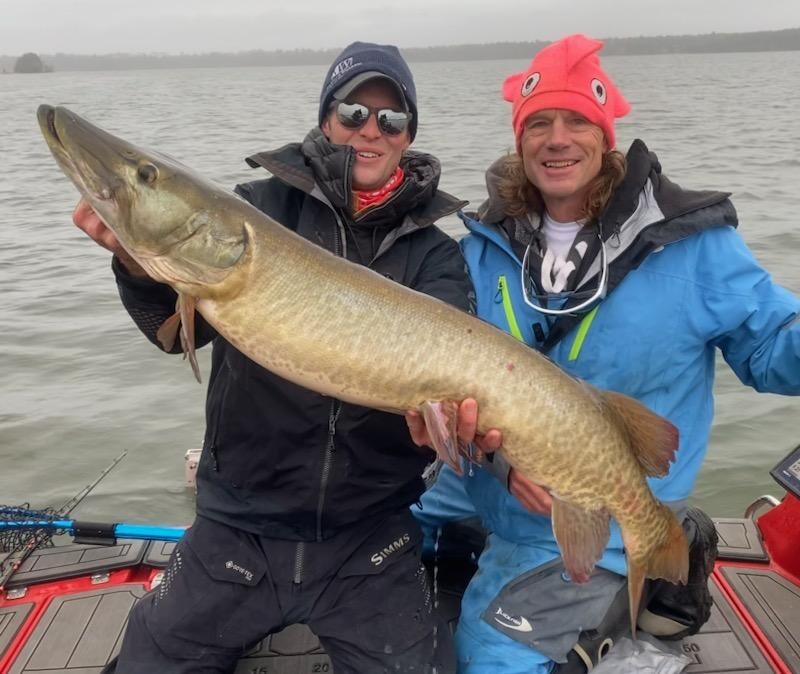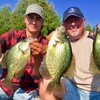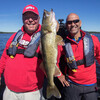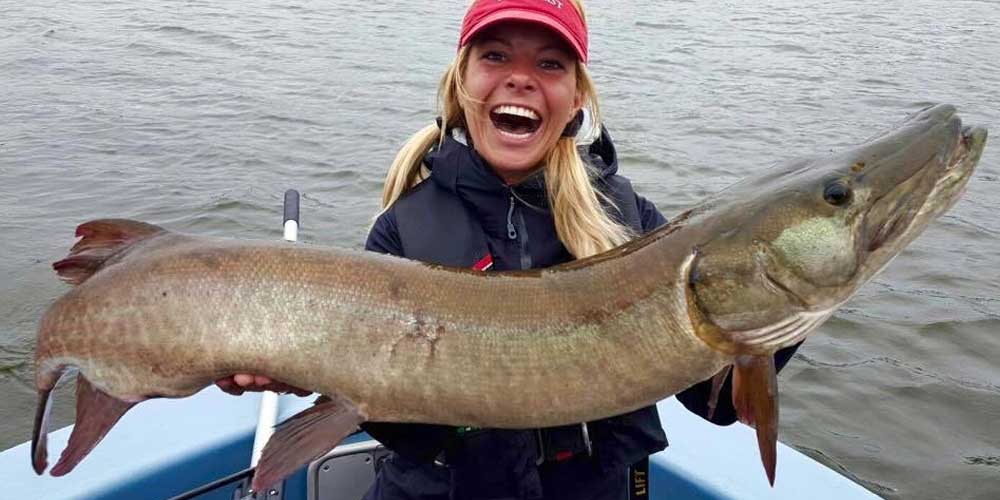
Eagle Lake Fall Muskies

Nearly everything is arguable, but over the years when asked the best time to fish Sunset Country's Eagle Lake, I answer fall—especially if you’re a trophy seeker. Eagle muskies have exceptional growth potential. Fall is prime time for heavy builds with maximum egg weight. Also important is the cold water bite has traditionally been very good. And, there is so much diversity in water to try—to potentially match any weather conditions —from gin-clear trout water on the northwest end to shallower, darker river water on the southeast end. There is so much to pattern it’s impossible to do it all in a day or a week. You will never be bored.
A good general rule is to try the clearer water sections on dark days and darker water when bright, with an open mind to other patterns. Overall, the muskie location will be deeper in fall and regardless of water colour it always makes sense from a patterning perspective—to target structures with deep water access (sharper breaks)—to be able to check all depth zones.

These Canadian Shield waters are beautiful, yet decisions with regard to best methods never come easy; if anything personal preference may be most important. A to cast/jig or troll decision should be somewhat based on fish location to target; electronics technology is truly amazing these days, allowing anglers to look for fish (target species and prey) - very effectively everywhere with the exception of super heavy cover. There are many miles of sharp-breaking shoreline as well as open water areas that can be holding fish. This type of structure is most efficiently fished via trolling, covering much more water in search of an aggressive fish. Trolling larger crankbaits is the most common and effective approach, hoping to pattern depth, lure action and color.
A much lesser used trolling method that can be very effective is hand-trolling soft plastics and/or jerk baits. While crank trolling covers more water with average effective speeds being 3 to 3.5 mph, the jerks and plastics are best slower at around 2 mph. Eagle Lake muskies just seem to love soft plastics in cold water. They can be trolled in rod holders, but like any jerkbait seem to produce better with anglers working the baits with a variety of pulls/jerks/twitches. Also, being soft bodied - means muskies can get a grip much easier than a hard bait - so hand holding is important for manual (with snap) hook sets as well. Jerk trolling is a hybrid method that is little used (good news because fish see less of it) and much more palatable to anglers who always like to be doing something other than looking at a rod holder. Another advantage to this method is that more precise (sharper breaks) structures can be worked when holding rods; as adjustments to depth can be more quickly made - to possibly drop the lure back a little or drastically raise it quickly for shallower zones.

The best jerkbaits to troll are generally the buoyant to neutral dive and rise type baits like Suicks and Bobbies; newer baits like the Livingston Flipper and Jerkmaster too. The fun part is you can try so many different actions with these baits and the strikes can be violent. Soft plastics are the same way - and there are so many different types these days - from paddle tails to tubes - to bulldawgs and toads. Depending on how hard you want to work at it, much can be done with the plastics, especially if want to go with more heavily weighted models … often Eagle muskies like those tipped with spinners … with all anglers paying attention to electronics - different depth ranges can be covered, purposefully crashing structure while adjusting baits up and then allowing lures to drop into deeper zones and holes. (This type of aggressive trolling on the structure is much more easily done with a tiller model boat, enabling quick turning reaction on sharp depth transitions.) If you haven't tried it and think trolling is boring - try hand-trolling plastics and your day will be anything but boring.
Generally, I recommend (and personally prefer) a combination of casting and vertical presentations on more classic complex structures on Eagle - defined as irregular, sharp breaking edges - often with a combination of weeds and rocks. Trolling can cover straighter edges and points fairly well, yet it’s impossible to effectively fish inside turns or distinct holes via trolling. Fall muskies are often bottom-related, and the only way to really put baits in their face is via boat control and vertical presentations.
When it comes to the “what to use” question - it’s always a tough one - as only one line a person is allowed. It can be tough to get live bait (generally suckers) in the fall, but Eagle Lake muskies like ‘em - and there are those days when they are the only thing working. It’s always important to note that the only way to safely use live bait - is with “quick” strike rigging - and setting the hook immediately after pick-up with the fish moving away. Swallowed hooks will result in death, but as long as the hookset occurs within 15 seconds it is actually the safest method for releasing the fish. Multiple anglers are ideal, allowing for at least one live bait out, as well as a caster checking shallower zones and one vertical jigging or casting a sinking bait and jigging it back in.
Boat position should be essentially in a zig-zag pattern on the sharp breaks on the structure for starters, until and if a distinct pattern in fish location is established. (Realistically it’s very rare, but occasionally all active fish will be coming from shallower or deeper zones and can adjust boat position in or out.) For checking those shallow zones crankbaits, jerks or non-weighted soft plastics are best. Unless you know spots well, a slightly buoyant crank is best - as there will be far less rock snagging. Soft plastics work great but do tend to be rock grabbers, so always keep them shallow at the start of the retrieve. A common pattern in the fall is muskie holding on or near the base of the break (where sharp depth drop levels off and often transitions from a hard to softer bottom). This is the pattern where vertical presentations are very often the most effective.

Often, cold water muskie and pike need their snacks dropped on their head to react - and with very sharp irregular breaks - vertical is the best way. A variety of weighted soft plastics work great for this (Bondys, Red October tubes…), as can flash baits like the Fuzzy Duzzit. Of course, this is where live baits can be deadly as well; certainly adding weight above the rig helps keep baits down in the fish zone and allows for moving the boat faster. Regardless of a prior day’s pattern in fish location and bait preference, it’s always best to start each day with a new slate and check for active fish locations. The word “active” is key as at times the tremendous tech will show a lot of fish in a particular zone - but in reality, they are not there to feed and it’s just a comfort thing. Never stay too long on inactive electronic fish (at least IMHO … waiting them out can work, but is boring).
Some days both live and artificial presentations seem to work equally well; however (and It has forever baffled me), I have seen it many times where it appears that live bait is getting all the attention; and then days too, when artificials are hot and live bait is ignored. Artificials can be best right to freeze up so watch for the patterns and adjust. If there are three or more anglers available, your odds go up significantly by running two or more live baits on days it’s preferred. On days when artificials are working well, it can be best to completely eliminate live bait and cover more water with lures.

Technology and trends are changing faster than I ever imagined I’d see these days. Anglers are so much better with the mapping available now (no longer are thousands of hours required to learn a lake well) and tech that now allows for seeing structures and fish all around the boat as well as below. The combination of more anglers and exceptional tech - means the number of times a fish sees a lure has gone up drastically in recent years. Fish can literally be seen and followed around … something “different” and/or new may be more important than ever. Eagle is a great lake, but it’s no secret that the big fish are there and many exceptional guides fish it. It pays to have a variety of presentations to try and to research the “hot thing” … so you can use it or possibly do exactly the opposite - if it’s been “hot” too long.
Definitely don’t get caught stubbornly using the same presentations with no success. And, be prepared to adapt your live bait game a little as well. It’s a good idea to have some kind of a float system for either working over shallower structure zones - or keeping the bait high (yet away from the boat) over deeper water on a suspended fish pattern. Also, have a variety of weights to try, and it’s always good to have a few jig rigs, especially if smaller live bait is all you can find. In some cases too, free-lining a sucker with no weight will get more strikes (not recommending around big rock). Adds like a Livingston sound bullet or blades in front or added to a jig rig may help trigger. If your electronics are letting you know muskies are seeing your baits - yet not hitting - a change in presentation could make a difference.

And, realistically, be prepared to simply wait ‘em out too, but strategically. The days where seeing fish and having action on and off all day are very few and far between; when it does occur it almost always coincides with small fronts moving through all day long. Otherwise, as muskies receive more pressure, see more lures and are caught more often - in many cases we only see them on peak activity periods, spurred by weather or lunar influence. Everything discussed earlier is good advice, via experience on the water - to up your odds of triggering a fish and patterning more active fish. The reality is though, most of your day will be slow or stop (because muskies suck), and you will be wondering if you’re doing anything right. Often, there will be only one or possibly two feeding windows during the course of a fall day; and with more pressured/educated fish it will be your only chance at catching muskie.
Be mentally prepared for it - so you keep working and keep your chin up. Certainly, always be aware of moon times during the day, and always ask other anglers when activity periods have been for them (unlike specific spots or lures you are likely to get the truth). Watch the weather and be aware of barometric pressure changes and arrivals of fronts. Regardless it’s very important to plan around likely times as much as possible. Eagle is a big lake and depending on wind conditions, travel on water can take up a lot of time. You never want to be travelling during a feeding window. If you normally eat lunch or break for a cocktail or whatever at a certain time … if it falls on a likely window - you need to be fishing instead.
Finally, the peak portion of a feeding window is often quite short. Be aware that any time the fish suddenly get active - after a period of inactivity (expected or not) - keep at it as quickly as possible while the fish are active. Save reliving the catch for later … hurry to get your lines back going if trolling, or if a fish came on a sucker get another one rigged immediately and get right back to it. It often seems like the average peak window is around 20 minutes, and getting back at it is often the difference between getting one or multiple fish. Certainly too, if you have a giant or several nice fish spotted - be on those fish at the right time to up your odds.
Recommended Articles

Christmas Walleyes in Summer

Fishing Walleye on Dog Lake

Ice Perchin’ Ontario

Year of the Trout

Gearing up for Ice Fishing

Sweet Spot Season

Stalking Prehistoric Long Nose Gar

Merkel's Camp

Eagle Lake Island Lodge

Dropshot the Shallows

Muskie Myths Part 2

Fishing Carp

Laurentian Lodge - Something for Everyone!

Birchland Cottages

Igniting the Spark

Magpie Reservoir

Eagle Lake Lodge: A Muskie Angler's Paradise

Manotak Lodge

Browns' Clearwater West Lodge

















